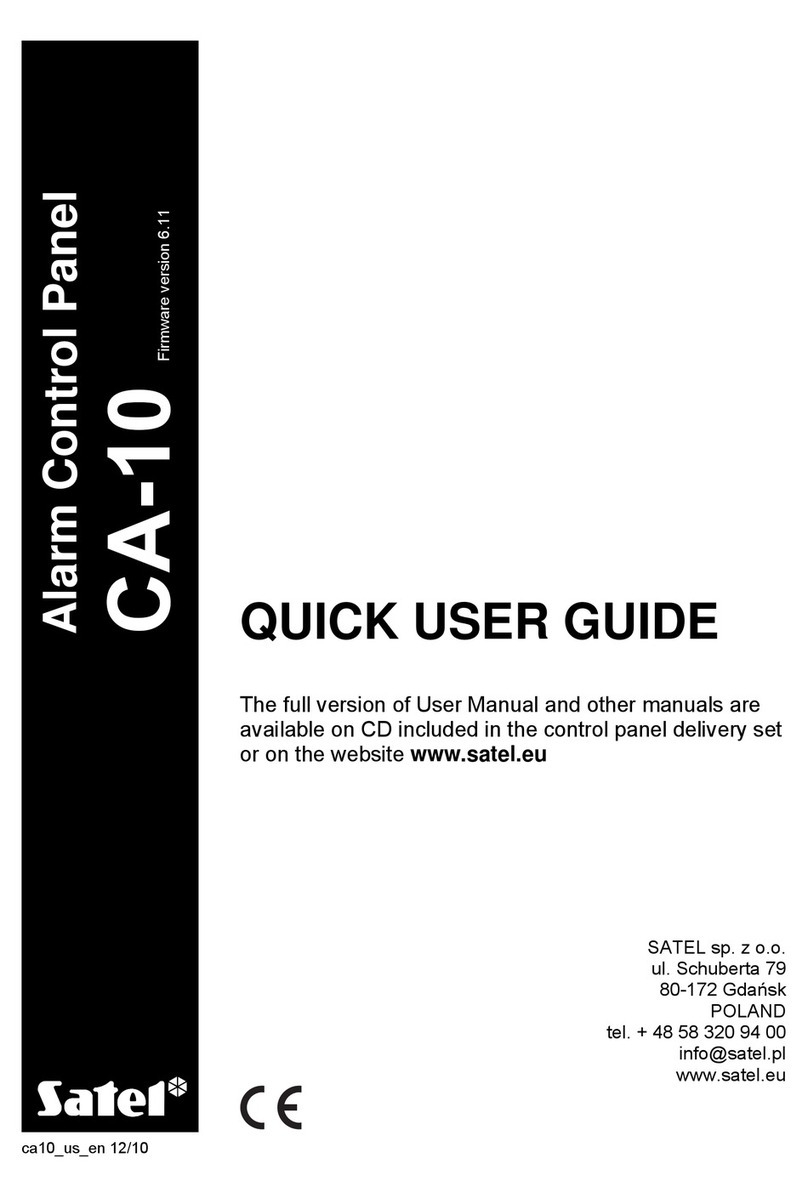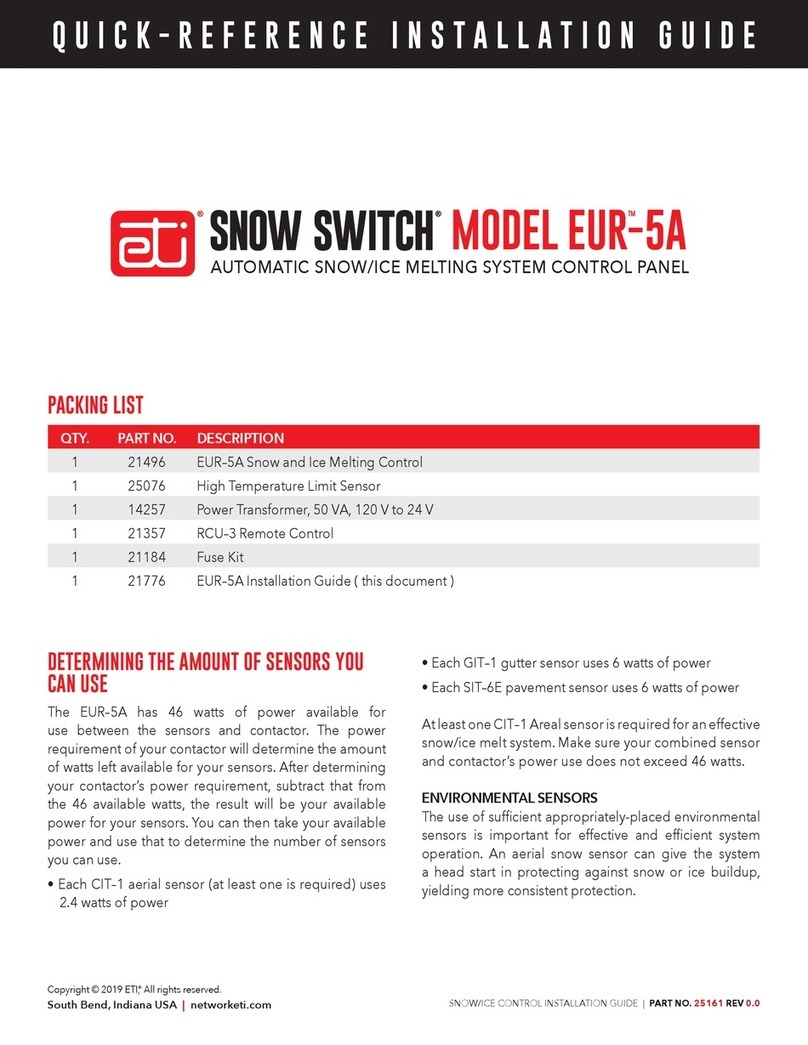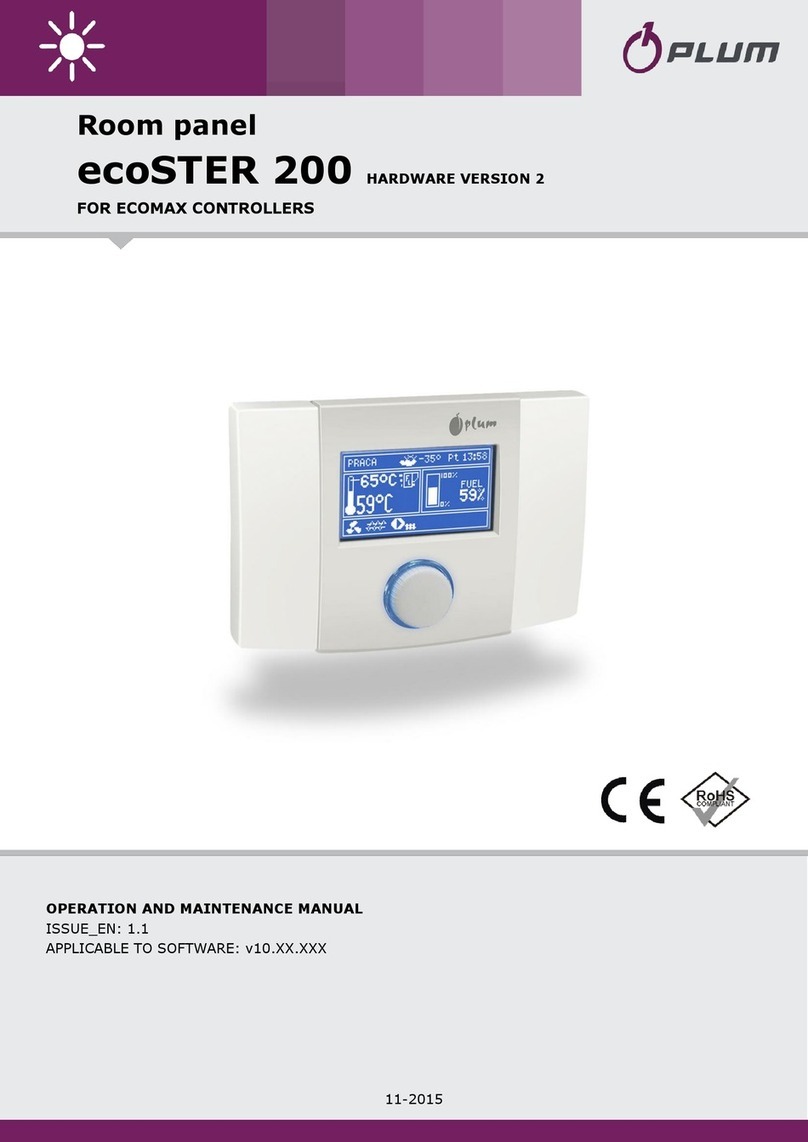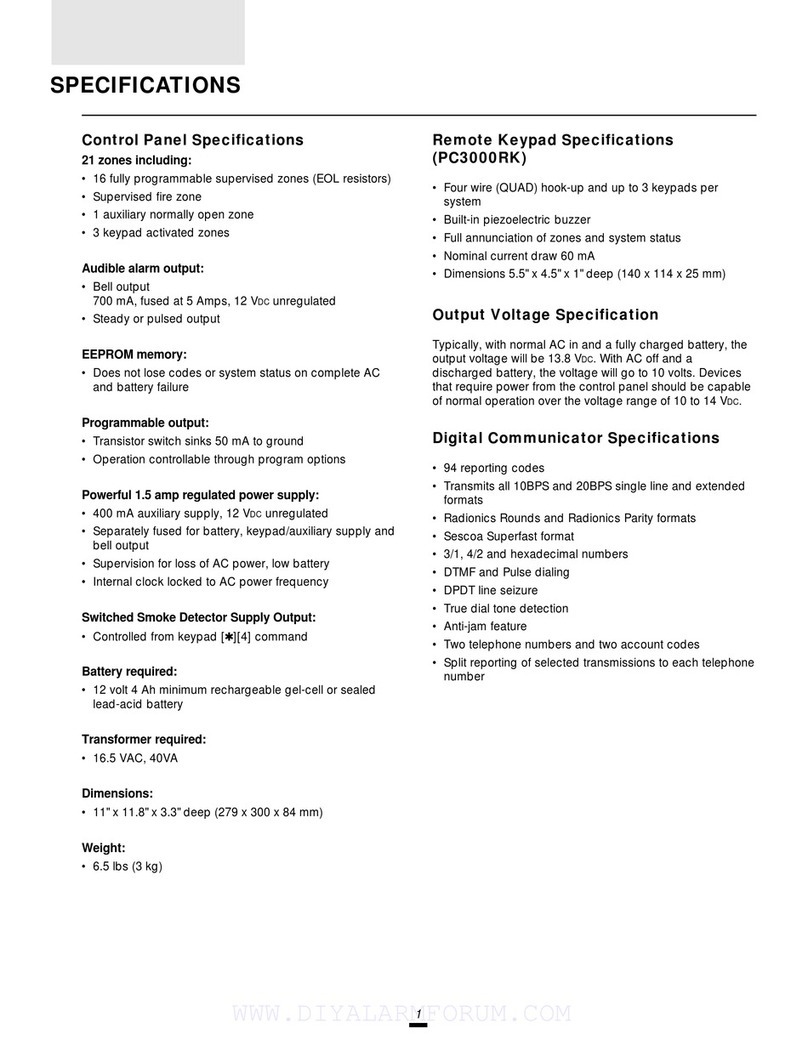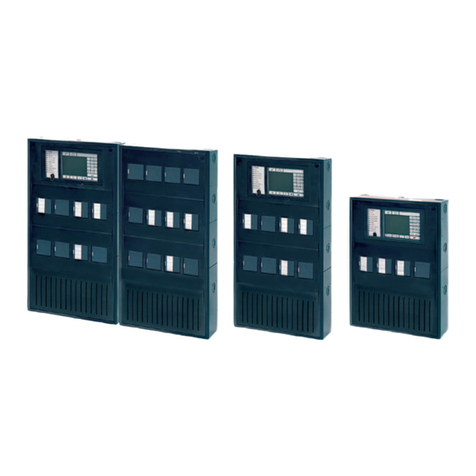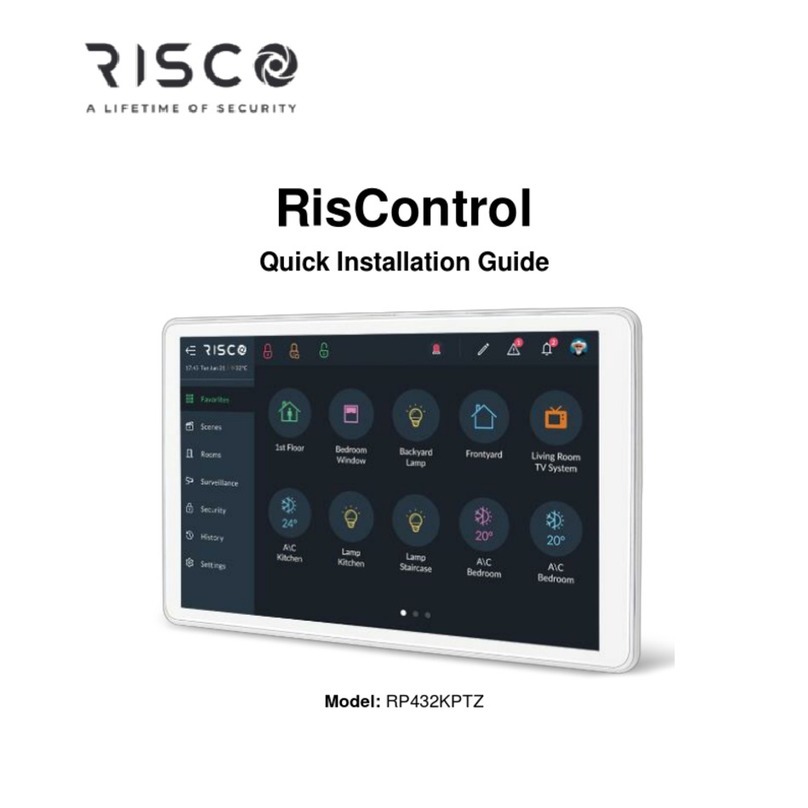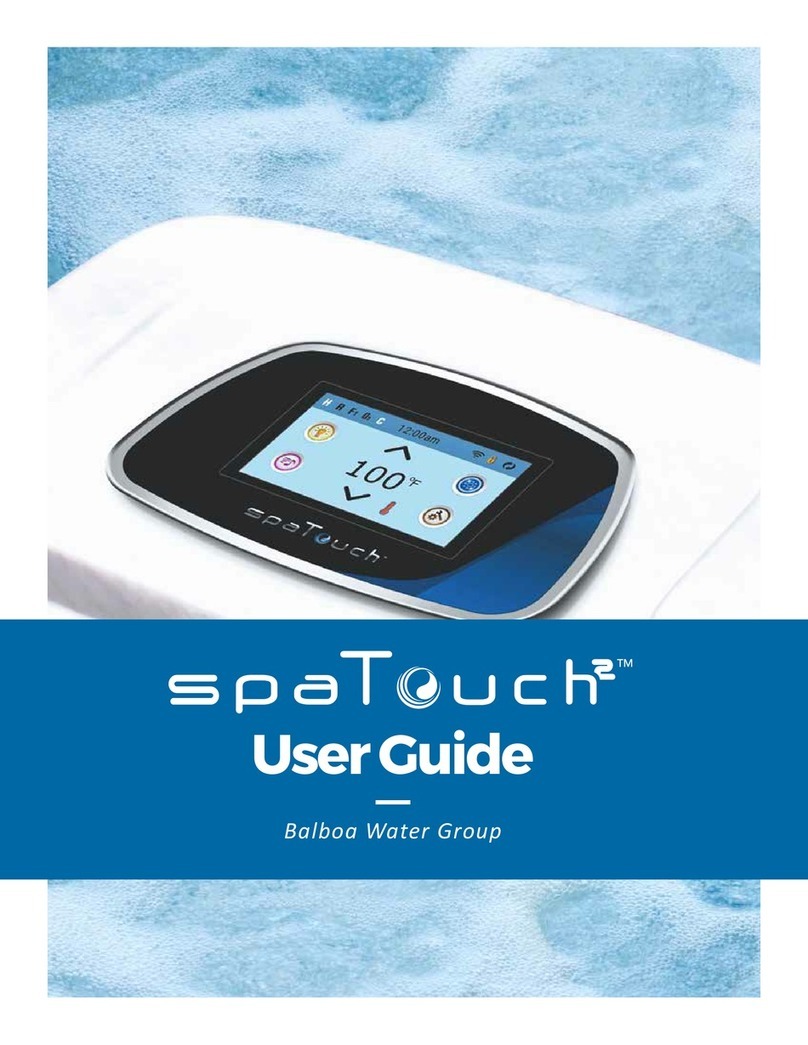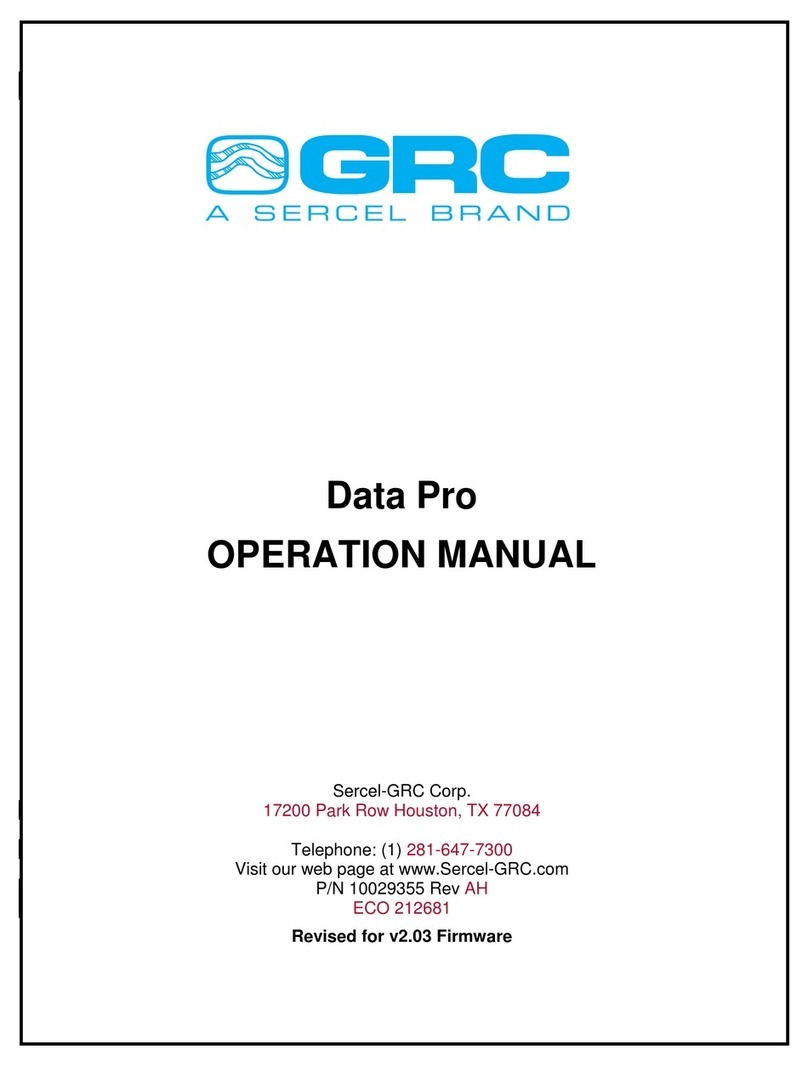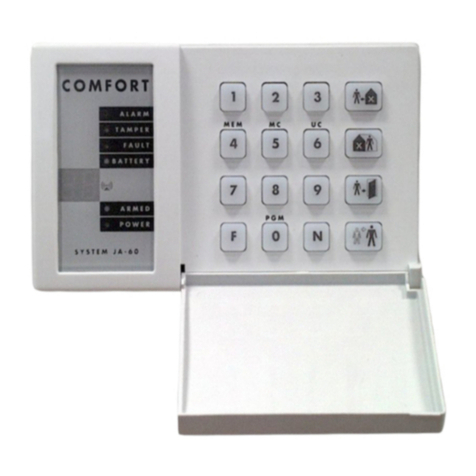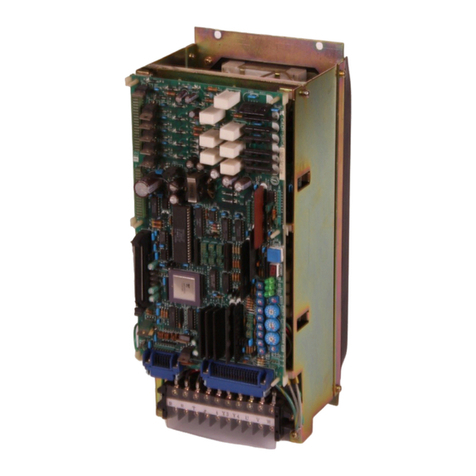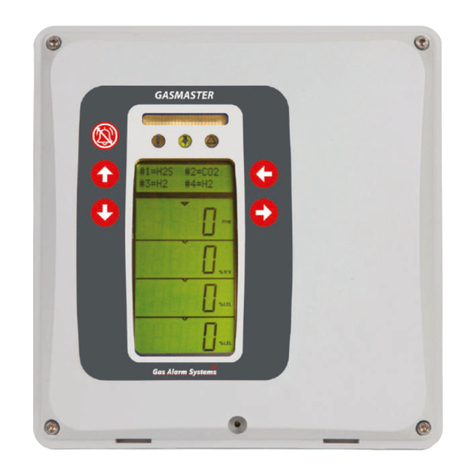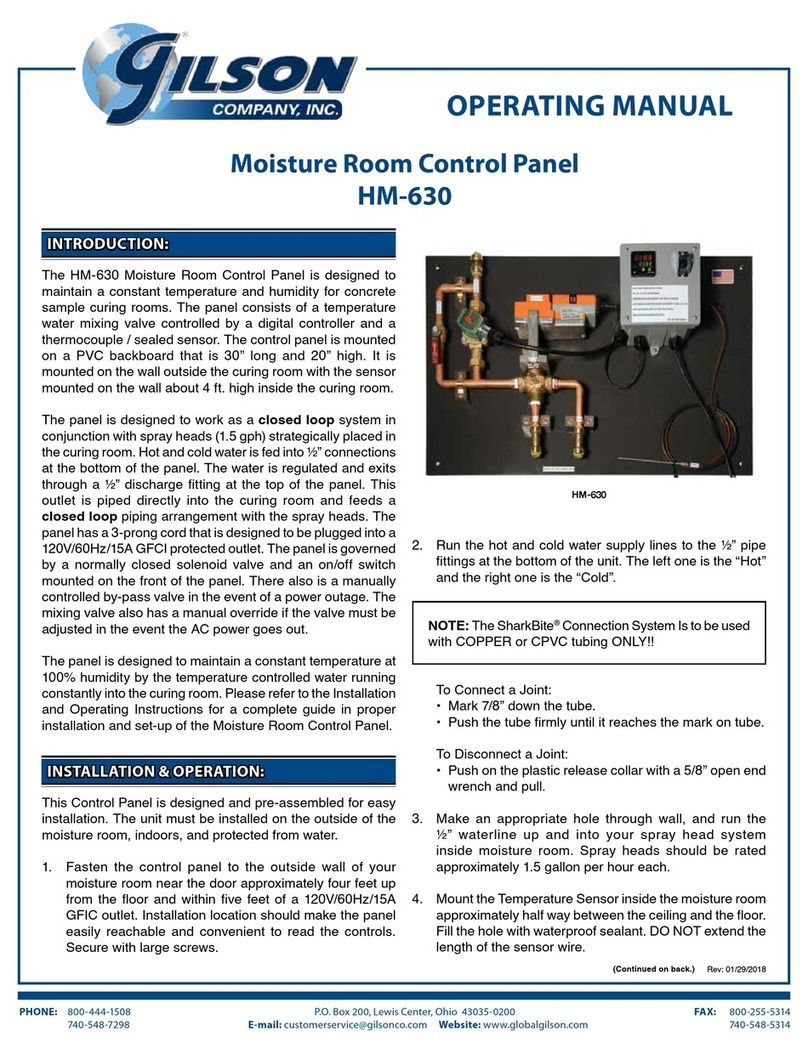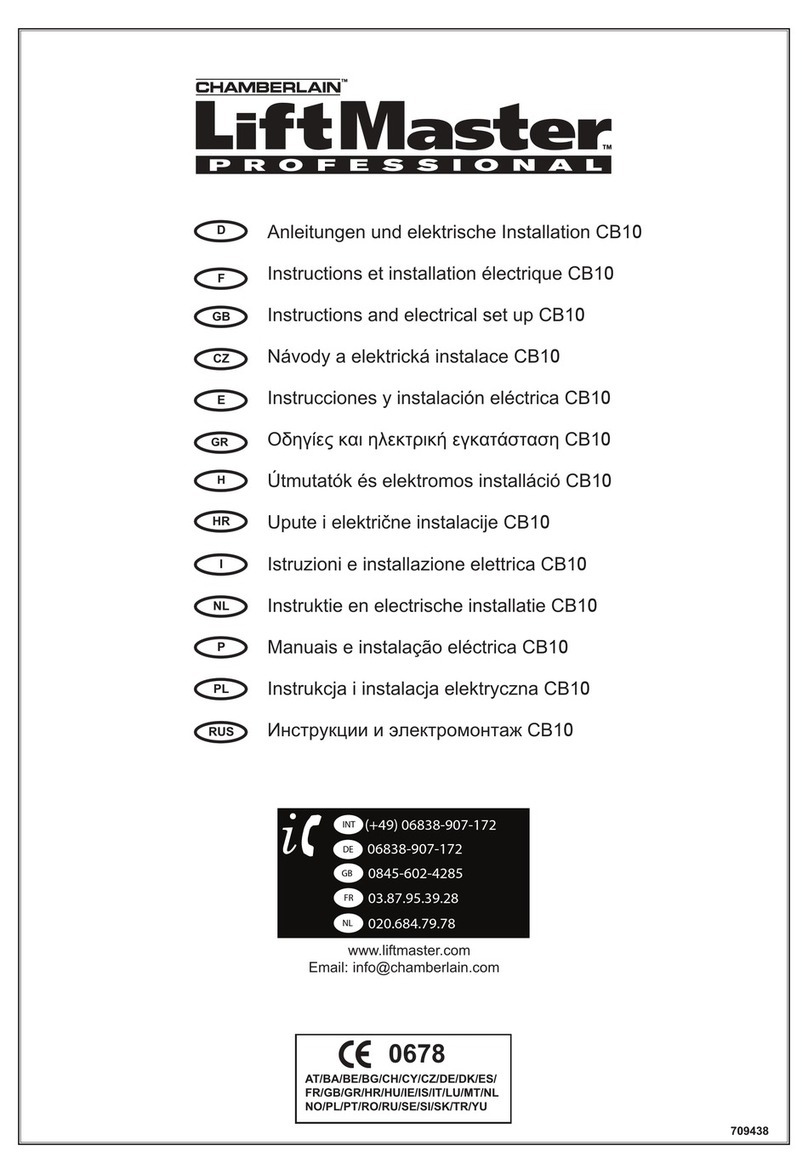Protectowire 2000 FireSystem Installation and operation manual

FIRE DETECTION CONTROL PANEL
OPERATING & MAINTENANCE MANUAL
An ISO 9001 Registered Company
APPROVED

IMPORTANT SERVICE NOTICE
When requesting service assistance, or to order parts for this
control panel, you are required to provide the Model Number,
Drawing Number and Serial Number. This product information
is recorded on the Panel Identification Label located inside the
control panel. Please have this information available before call-
ing your Authorized Protecto ire Distributor or the Factory.

60 Washington Street, Pembroke, MA 02359-1833 USA
Tel. (781) 826-3878
Fax (781) 826-2045
Visit us on the World Wide Web at:
GGG@B?D53D?G9B53?=
))5B95C9B55D53D9?>?>DB?<&1>5<
%@5B1D9>7#19>D5>1>35#1>E1<
Part Number MAN-2000
Revision Date: June 1, 2011

~ 1~
*12<5?6?>D5>DC
Page No.
$?D935 3
)/)*#)&*%$)$)*""*%$$%&(*%$
))5B95C?>DB?<&1>5<
Information and Specifications . . . . . . . . . . . . . . . . . . . . . . . . . . . . . . . . . . . . . . . . . . . . . . . . . . . . . . . . . . . 4-5
Standard nclosure Mounting Dimensions . . . . . . . . . . . . . . . . . . . . . . . . . . . . . . . . . . . . . . . . . . . . . . . . . . . . 6
LTi2X nclosure Mounting Dimensions . . . . . . . . . . . . . . . . . . . . . . . . . . . . . . . . . . . . . . . . . . . . . . . . . . . . . 7
LTi4 - LTi9 nclosure Mounting Dimensions . . . . . . . . . . . . . . . . . . . . . . . . . . . . . . . . . . . . . . . . . . . . . . . . . 8
Alarm Notification Appliance Circuit - Wire Size stimator (DS-9066) . . . . . . . . . . . . . . . . . . . . . . . . . . . . . 9
Standby Battery - Size Calculation . . . . . . . . . . . . . . . . . . . . . . . . . . . . . . . . . . . . . . . . . . . . . . . . . . . . . . . . . 10
Typical Panel Field Wire Routing Detail . . . . . . . . . . . . . . . . . . . . . . . . . . . . . . . . . . . . . . . . . . . . . . . . . . . . 11
Installation and System Power-Up Outline . . . . . . . . . . . . . . . . . . . . . . . . . . . . . . . . . . . . . . . . . . . . . . . . . . . 12
Test and Maintenance Outline . . . . . . . . . . . . . . . . . . . . . . . . . . . . . . . . . . . . . . . . . . . . . . . . . . . . . . . . . . . . . 13
System Operational Outline . . . . . . . . . . . . . . . . . . . . . . . . . . . . . . . . . . . . . . . . . . . . . . . . . . . . . . . . . . . .14-15
Troubleshooting - Basic Troubleshooting Guide . . . . . . . . . . . . . . . . . . . . . . . . . . . . . . . . . . . . . . . . . . . . 16-17
Parts Replacement - Instructions . . . . . . . . . . . . . . . . . . . . . . . . . . . . . . . . . . . . . . . . . . . . . . . . . . . . . . . . . . . 18
)/)*##$%#&%$$*)$"-($
)ICD5=#19>?1B4 - Description, Controls and Field Wiring . . . . . . . . . . . . . . . . . . . . . . . . . . . . . . . . . . . . . . 19-22
-9B55D53D?B&?G5B - Supervision . . . . . . . . . . . . . . . . . . . . . . . . . . . . . . . . . . . . . . . . . . . . . . . . . . . . . . . . . . . . 23
H@1>45B?1B4 - Description, Accommodations and Field Wiring . . . . . . . . . . . . . . . . . . . . . . . . . . . . . . . . . . 24-26
?>DB?<1B4- Description, Variations and Controls . . . . . . . . . . . . . . . . . . . . . . . . . . . . . . . . . . . . . . . . . . . . . . 27-28
0?>51B4- Description, Variations and Controls . . . . . . . . . . . . . . . . . . . . . . . . . . . . . . . . . . . . . . . . . . . . . . . . 29-30
)/)*#%&*%$"%#&%$$*)$"-($-(&&""
%&*%$ Page No.
“A” Protectowire Alarm Point Location Meter (PDM) . . . . . . . . . . . . . . . . . . . . . . . . . . . . . . . . . . . . . . . . . .31
“C” 16 Zone Alarm Scanner (NDS-91-16) . . . . . . . . . . . . . . . . . . . . . . . . . . . . . . . . . . . . . . . . . . . . . . . . . . . . 32
“D” Waterflow Detection Card (ZC-91AW) . . . . . . . . . . . . . . . . . . . . . . . . . . . . . . . . . . . . . . . . . . . . . . . . 33-34
“ ” Switch Supervisory Card (SC-91A) . . . . . . . . . . . . . . . . . . . . . . . . . . . . . . . . . . . . . . . . . . . . . . . . . . . . . 35
“F” Solenoid Release/Switch Supervisory Board - Field Wiring . . . . . . . . . . . . . . . . . . . . . . . . . . . . . . . . . . 36
Solenoid Release / Detection Zone Field Wiring . . . . . . . . . . . . . . . . . . . . . . . . . . . . . . . . . . . . . . . . . . . 37
Solenoid Release Card Jumper Settings . . . . . . . . . . . . . . . . . . . . . . . . . . . . . . . . . . . . . . . . . . . . . . . . . . 38

%&*%$ Page No.
“H” Intrinsic Safety Barrier for Special Hazard Applications . . . . . . . . . . . . . . . . . . . . . . . . . . . . . . . . . . . . . 39
“H” Intrinsic Safety Barrier Field Wiring Illustration (IL-1008) . . . . . . . . . . . . . . . . . . . . . . . . . . . . . . . . . . . .40
“K” Intrinsic Safety DC Isolator for Special Hazard Applications . . . . . . . . . . . . . . . . . . . . . . . . . . . . . . . . . 41
“K” Intrinsic Safety DC Isolator Field Wiring Illustration (IL-1008-2) . . . . . . . . . . . . . . . . . . . . . . . . . . . . . . 42
“L” “LL” Auxiliary Zone Alarm Relays . . . . . . . . . . . . . . . . . . . . . . . . . . . . . . . . . . . . . . . . . . . . . . . . . . . . . . . . . . 43
“P” Battery Charger Status Meters (PWM-V-A) . . . . . . . . . . . . . . . . . . . . . . . . . . . . . . . . . . . . . . . . . . . . . . . 44
“Q” Time Delay Relay . . . . . . . . . . . . . . . . . . . . . . . . . . . . . . . . . . . . . . . . . . . . . . . . . . . . . . . . . . . . . . . . . . . 44
“R” Common Alarm Signaling Relay (CAS) . . . . . . . . . . . . . . . . . . . . . . . . . . . . . . . . . . . . . . . . . . . . . . . . . . 45
“S” Common Trouble Signaling Relay (CTS) . . . . . . . . . . . . . . . . . . . . . . . . . . . . . . . . . . . . . . . . . . . . . . . . . 45
“RR” Auxiliary Relay Module (RB-98) . . . . . . . . . . . . . . . . . . . . . . . . . . . . . . . . . . . . . . . . . . . . . . . . . . . . . . . 46
“T” Class A Alarm Notification Appliance Circuit Adapter (AM-91) . . . . . . . . . . . . . . . . . . . . . . . . . . . . . . . 47
“U” Alarm xpander Card (A -91) . . . . . . . . . . . . . . . . . . . . . . . . . . . . . . . . . . . . . . . . . . . . . . . . . . . . . . . . . 48
“V” Zone Voting Module (ZV-91) . . . . . . . . . . . . . . . . . . . . . . . . . . . . . . . . . . . . . . . . . . . . . . . . . . . . . . . . . . 49
“W” Auxiliary Power Supply (PS-91) . . . . . . . . . . . . . . . . . . . . . . . . . . . . . . . . . . . . . . . . . . . . . . . . . . . . . . . . 49
Preaction Double Interlock Deluge Cross-Zoning - Applications Data Sheet . . . . . . . . . . . . . . . . . . . . . 50
“X” Dual Temperature Zone Card (ZC-95) . . . . . . . . . . . . . . . . . . . . . . . . . . . . . . . . . . . . . . . . . . . . . . . . . . . 51
“X” Dual Temperature Zone Card Field Wiring . . . . . . . . . . . . . . . . . . . . . . . . . . . . . . . . . . . . . . . . . . . . . . . . 52
“Y” Power Conditioning Module (PS-95) . . . . . . . . . . . . . . . . . . . . . . . . . . . . . . . . . . . . . . . . . . . . . . . . . . . . 53
“Z” xternal Key Operated Switches . . . . . . . . . . . . . . . . . . . . . . . . . . . . . . . . . . . . . . . . . . . . . . . . . . . . . . . . 54
Preaction Manual Release Station and Releasing Agent Dead Man Abort . . . . . . . . . . . . . . . . . . . . . . . . . . . . . . . . . 55
FS2000 Series Alarm Control Panel Instructions - To Be Mounted Adjacent to the System nclosure . . . . . . . . . . .56
Appendix A........................................................................................................................................................................
Listed Solenoids, Notification Appliance Devices, Listed Smoke Detectors...........................................................57-59
~ 2~
*12<5?6?>D5>DC(continued)

$?D935
Testing and maintenance of system controls shall be performed by competent, qualified personnel having
jurisdiction over this protective signaling system.
This system may contain detection zones which are assigned to trip release solenoids and/or equipment shut-
down. As a deterrent to accidental activation of the release system, the control card module for systems so
equipped does not have a system test (alarm simulate) button.
Testing zones with solenoid release circuits and equipment shutdown contacts may be accomplished by use
of a jumper wire across the detection/initiating circuit field wiring terminals only after all the solenoid dis-
connect switches on the release modules are depressed to the disconnect (down) position and all equipment
shutdown contacts are bypassed.
9B5?>DB?<&1>5<=ECD25D5CD54G9D816E<<I381B754,?<D21DD5BIC5D19<EB5D?4?C?=1IB5CE<D
9>CICD5=619<EB5
-1B>9>7
Fatal electrical sh ck and equipment
damage may result fr m failure t rem ve
all p wer pri r t servicing system.
~ 3~
1ED9?>
The Protectowire Co. Inc. designs and manufactures fire protection systems to meet both UL and FM Global
criteria for electrical transients introduced on both the power supply side of the system and into the panel
from field wiring for initiating device circuits, notification applaince circuits, and other external field routed
wiring.
Fire protection systems located in areas subject to lightning strikes, or subject to other severe transients, and
electromagnetic interference, should be protected similar to computers and other electronic systems with
supplemental surge and filter protection both on the power supply side and on the field wiring for initiating
device circuits, notification appliance circuits and other field routed wiring.
Please refer to surge/filter manufacturers, (eg. DIT K 800-753-2345, www.ditekcorp.com) to specify
devices for your particular conditions. The National Lightning Safety Institute (www.LightningSafety.com)
also provides valuable information regarding the problems and solutions of providing lightning protection
including assuring true earth ground conditions.
Lightning strikes, other severe power surges, and MI/RFI interference, by their nature, are beyond normal
design criteria and are outside the warranty for manufacturing defects.

))5B95C9B55D53D9?>
5<E75&B513D9?>?>DB?<&1>5<>6?B=1D9?>1>4)@5396931D9?>C
The FS2000 Series of multiple zone fire protection panels is the latest in fire protection from The Protectowire Company, Inc. The
standard model provides, as a minimum, 2 (Class A or B) initiating device circuits and the following standard features:
- xpandable (in multiples of two zones) - Ground Fault Detection (not applicable to all systems)
- Two Supervised Notification Appliance Circuits - Alarm Lock-in until Reset
- On Board Audible Indicator Silencing - On Board System Reset Button
- Lamp and System Trouble Circuit Test - Dry Alarm and Trouble Contacts
- Initiating Device (Detection) Circuit -IDC- ALARM Test
- Monitors up to 5,000 ft. (1,524 meters) of PROT CTOWIR Linear Heat Detector Cable per circuit
- Any combination of normally open contact devices
- Accommodates up to (30) NS-series #SLR-24, #SIJ-24, #SLR-24H, Detector Identifier - HD-3
Smoke Detectors (per circuit).
- Battery Monitoring, Low or Out of operating specs. (or disconnected)
)ICD5=)@5396931D9?>C
$?D96931D9?>@@<91>359B3E9DC
N te: Circuits do NOT generate a temporal pattern signal. Appliances that can generate a temporal pattern must be employed
when a temporal pattern is required. Reference DS-9066 in this manual for compatible devices.
~ 4~
&B9=1BI&?G5B 120VAC 50/60Hz 1.75 amp maximum ** see below
)E@@?BD54)D1>42I1DD5B95C 24VDC 4.5AH minimum to 60AH maximum * see below
1DD5BI81B75B 27VDC 1.25 Fast charge, 27.6mA Max trickle charge, 12mA (typical)
&B9=1BI)ICD5=&?G5B 24V FWR by T1, 175VA typical. Greater VA rating as required by system
)ICD5=(57E<1D54&?G5B MB and B type boards provide 12 & 24VDC regulation. RS type boards
provide24VDC regulation only
?==?><1B=?>D13DC 3 amps @ 30VDC, resistive load, silenceable
?==?>*B?E2<5?>D13DC 1 amp @ 24VDC, resistive load, factory preset as non-silenceable
?==?>)E@5BF9C?BI?>D13DC 1 amp @ 24VDC, resistive load, programable
?EBG9B545D53D?B@?G5B 24VDC @ 200mA Max. used for Special Application
(non-supervised, for supervision use PSR-2040)
>F9B?>=5>D1<?@5B1D9>7
3?>49D9?>C
Ambient temperatures: 32 - 120 degree F (0 - 49 degrees C)
Humidity: Max. 95% relative non-condensing
*Battery requirements calculated per individual system demands. (See battery selection data)
**240VAC 50/60 Hz 0.85amp maximum also available. Check installation wiring diagram (IWD).
,?<D175 24 V Full wave rectified (FWR) with battery standby.
EBB5>D Two am s er circuit three am s maximum combined
Maximum two conductor copper feed cable resistance may not exceed 1 ohm (see below
1.4 Volts Maximum Line Loss
- Maximum of 500’ (feet)
- Maximum of 300’ (feet)
N- Maximum of 200’ (feet)
Note: Notification Appliance Circuits current rating may be reduced depending on
each systems current requirements. Reference the installation wiring diagram (IWD)
for individual systems actual ratings. Reference DS-9066 for more information

))5B95C9B55D53D9?>
5<E75&B513D9?>?>DB?<&1>5<>6?B=1D9?>1>4)@5396931D9?>C
(continued)
$**$(+*)
Class A (NFPA Style D)/Class B (NFPA Style A and B)
>4?6<9>5B5C9CD?B 4.7K ohm
1/2 watt
(Class B
only)
#1H9=E=6554312<5
100 ohms.
(ELR-HD-4-QC)
*/&"**%$(+*"-($
$**$,)
+C5D856?<<?G9>73?=@1D92<545F935C1@@B?F542I*85&B?D53D?G9B5?=@1>I>3
- Up to 5,000 ft. of PROT CTOWIR per circuit
- Any combination of normally open contact devices.
N te: Maximum feed cable resistance = 100 ohms Feed cable may consist of any combination
of PROT CTOWIR or copper wire.
- Up to (30) Two-Wire Smoke Detectors per circuit.
- Smoke Detectors NS-series #SLR-24V, #SIJ-24, #SLR-24H
- Detector Identifier - HD-3, Base Identifier - HB-3
N te: Smoke detectors shall not be employed on intrinsically safe detection circuits.
,?<D175)D1>42I 22VDC nominal, power limited
EBB5>DD?5>CEB51<1B= 15mA (1K ohm loop resistance minimum)
)8?BD39B3E9D3EBB5>D 35mA
)E@5BF9C9?>3EBB5>D 4.5mA
~ 5~

))D1>41B4>3<?CEB59=5>C9?>C
(all dimensions in inches)
~ 6~
nclosure Back Box Dimension Reference Table
IMPORTANT: The above stated dimensions are for the enclosure back box only and do not account for
the overall dimensions of the enclosure with the door installed. To account for the enclosure door and
hinges add an additional 0.5” to the back box width (Dimension B) and 0.1” to the back box depth
(Dimension C).
Cauti n: ?>?D4B9<<D8B?E78D85D?@?6D855>3<?CEB56?B3?>4E9D5>DBI#5D1<69<9>7C1>4?BG1D5B5>DBI
6B?=3?>4E9DCICD5=G9<<41=175CICD5=3?=@?>5>DC1>4F?94C613D?BIG1BB1>DI+C5;>?3;?EDC
@B?F94541>4C51<1<<3?>4E9D?@5>9>7C
*/& (%-) %"+#$) )&)
N2 17” 21” 4.75” 15” 19” 6” 1 2 2
N4 31” 21” 4.75” 29” 19” 6” 2 2 4
N6 31” 26” 4.75” 29” 24” N/A 2 3 6
N9 42” 26” 4.75” 40” 24” N/A 3 3 9
N12 53” 26” 4.75” 51” 24” 20” 4 3 12
N15 64” 26” 4.75” 62” 24” 29” 5 3 15

)"*9.>3<?CEB59=5>C9?>C
(all dimensions in inches)
nclosure Dimension Reference Table
*/& (%-) %"+#$) )&)
LTi2X 17.5” 19.5” 9” 12” 18.85” 21 2
N te: nclosure shown represents the LTi2X only. For LTi4 - LTi9 dimensions reference the
LTi4 -LTi9 dimensions page of this manual.
Cauti n: ?>?D4B9<<D8B?E78D85D?@?6D855>3<?CEB56?B3?>4E9D5>DBI#5D1<69<9>7C1>4?BG1D5B5>DBI6B?=
3?>4E9DCICD5=G9<<41=175CICD5=3?=@?>5>DC1>4F?94C613D?BIG1BB1>DI+C5;>?3;?EDC@B?F94541>4C51<1<<
3?>4E9D?@5>9>7C
~ 7~
A D

nclosure Dimension Reference Table
*/& (%-) %"+#$) )&)
LTi4 35.25” 24” 6.85” 34” 18” 22 4
LTi6 35.25” 29” 6.85” 34” 23” 23 6
LTi9 46.25” 29” 6.85” 45” 23” 33 9
N te: nclosure shown represents the LTi4, 6 and 9 only. For LTi2X dimensions reference the
LTi2X dimensions page of this manual.
Cauti n?>?D4B9<<D8B?E78D85D?@?6D855>3<?CEB56?B3?>4E9D5>DBI#5D1<69<9>7C1>4?BG1D5B5>DBI
6B?=3?>4E9DCICD5=G9<<41=175CICD5=3?=@?>5>DC1>4F?94C613D?BIG1BB1>DI+C5;>?3;?EDCG85>
@B?F94541>4C51<1<<3?>4E9D?@5>9>7C
)"*9"*9>3<?CEB59=5>C9?>C
(all dimensions in inches)
~ 8~
COLUMNS
A D

))5B95C<1B=9B3E9D>CD1<<1D9?>E945
)CCE54
<1B=$?D96931D9?>@@<91>359B3E9D-9B5)9J5CD9=1D?B
To ensure that all alarm notification appliance circuits will be supplied with adequate power to operate, it is
necessary to use the correct size feed cable for the distance and current requirement of each circuit. Follow the steps
below to calculate the correct wire size for your application. The calculations are based on a maximum line loss (voltage
drop) of 2 volts.
1. Calculate the required alarm device current.
(Number of Devices) X (Device Current) = Total Alarm Device Current (amps).
2. Determine the wire run distance in feet from the panel to the last alarm device.
3. Find the load current (amps) on Table 3 that best matches the required alarm device current. If the device current is in
between two values, use the higher value.
4. Find the wire run distance to the right of the device current value chosen in Step 3 which is greater than your require-
ment.
5.
The gauge at the top of the distance column is what will be required to ensure a maximum line loss of less than 2 volts.
XAMPL : If the total alarm device load is .680 amps; select .750 amps. If the measured distance is 400 ft.; select
517 ft. which is in the 14 AWG column.
AWG = AM RICAN WIR GAUG
*12<5?=@1D92<5,
&?<1B9J54)97>1<5F935C *12<5?@@5B-9B5(5C9CD1>35
%#)&(*
+- )$"%$+*%(
10 1.018
12 1.619
14 2.575
16 4.094
18 6.510
*12<5<1B=>4931D9>79B3E9D-9B5)9J5
6?B,&?<1B9J545F935C
*%%$+*%(-(
18 AWG 16 AWG 14 AWG 12 AWG 10 AWG
0.060 2550 4050 6450 10250 16350
0.125 1200 1950 3150 4900 7850
0.250 600 950 1550 2450 3900
0.375 400 650 1000 1600 2600
0.500 300 450 750 1200 1950
0.625 200 350 600 950 1550
0.750 200 300 500 800 1300
1.000 150 200 350 600 950
1.250 100 150 300 450 750
1.500 100 150 250 400 650
1.750 50 100 200 350 550
2.000 50 100 200 300 450
*%*"
,
"%
#&)
N te: the maximum alarm indicating circuit resistance is
calculated for a line loss of 2 volts divided by the maxi-
mum alarm device current.
~ 9~
DEVICE MFGR. MODEL AMPS
H24W 0.035
AMESCO HW-24 0.035
WHEELOCK MIZ 0.043
HORNS
FEDERAL 450 0.25
MBA-6-24 0.012
AMESCO MBA-8-24 0.025
MOTOR
BELLS
WHEELOCK MB 0.030
SLW24W 0.120
AMESCO SAD24 0.250
AHWP 0.100
WHEELOCK ASWP 0.113
STROBE
FEDERAL LP3SERIES 0.22
SHW24W 0.088
AMESCO SHP24 0.250
HORN/
STROBE
WHEELOCK NS4 0.361
AV1ST 0.39
STROBE/
BUZZER FEDERAL AV1 0.98
For complete list of Notification Appliance Devices and
their corresponding current draw )N&&$.N

))5B95C9B5<1B=?>DB?<&1>5<
1DD5BI)9J51<3E<1D9?>)855D
Use this form to calculate the required battery size for your system. You must first determine the duration the panel
will need to function on batteries in hours. The installation wiring diagram for your system includes a factory calculat-
ed battery size in the specification section. This calculation is based on a 24-hour backup period for non-releasing
systems and a 90 hour backup period for systems with a solenoid releasing module. An alarm duration or period of
time the system must operate in full alarm mode after the backup period has expired is assumed to be 15 minutes or
0.25 hours. This may be altered as necessary.
~ 10 ~
FORMULAS AND VARIABLES
System Standby Current in amperes = (I1) Standby Time in Hours = (H1) Battery Size De-rate Divisor = (0.85)
System Alarm Current in amperes = (I2) Alarm Time in Hours = (H2)
System Battery Size required in ampere hours – [(I1 X H1) + (I2 X H2)] / 0.85 = Battery Size (AH) Note: Use next largest size
SYSTEM STANDBY CURRENT CALCULATIONS – Enter Quantities of Installed Options only
Option DescriptionQuantityCurrent Product
&3"ASE3YSTEM8!:ONESOFDETECTIONZONESMULTIPLESOFONLYIEx8!h#vZONE!LARM3CANNERAND%XPANDERSQUANTITYBETWEENAND8!h$v7ATERFLOW:ONE#ARDQUANTITY$$x8!h%v3WITCH3UPERVISORY:ONE#ARDQUANTITIES%%x8!h&v3OLENOID2ELEASE#ARD23QUANTITIES&&x8!h5v!LARM%XPANDER#ARDQUANTITIES55x8!h6v:ONE6OTING-ODULEQUANTITIES66x8!h8v$UAL4EMPERATURE:ONE#ARDQUANTITIES88x8!h9v0OWER#ONDITIONING-ODULE/PTION9n3EE.OTE!8/THERWIRE3MOKE$ETECTORS56)2$ETECTORS3EE.OTE!8Note A:1UANTITYAND#URRENTDETERMINEDBYOFDEVICESINSTALLEDANDCURRENTRATINGOFEACHDEVICESTotal (I1)
SYSTEM ALARM CURRENT CALCULATIONS- Enter Quantities of Installed Devices only
Device Description Quantity Current Product
PDM-1000-2 Digitial Meter X 0.100A
Auxiliary Relay Module RB-98 (Option “RR”) X 0.104A
AM-91-1 Class A Alarm N.A.C. Adapter X 0.004A
Solenoid Valve (See Complete list / Current draw in Appendix A) X
Auxiliary Relays SPDT (Option “L”) X 0.015A
Auxiliary Relays DPDT (Option “LL’) X 0.035A
MB Bells (Wheelock) X 0.030A
SZ5424 Series Horn/Strobe (Amesco) X 0.250A
VALS-24 Strobe Light (Federal) X 0.080A
450 Vibratone Horn (Federal) X 0.025A
SFH Speaker / Strobe Combination (Amesco) X 0.114A
MTWP Series Horn / Strobe (Wheelock) X 0.126A
See Complete list and current draw in Appendix A
Subtotal
System Standby Current (Total I1 from Calculations above) 1 X
Total (I2)
AVAILABLE BATTERIES
Catalog # Rating (AH) Battery Cabinet
03!(.OTREQUIRED03!(.OTREQUIRED03!(.OTREQUIRED03!(%RED%"BEIGE03!(%RED%"BEIGE03!(%RED%"BEIGE2EQUIREDFOR%.ENCLOSUREn.OTREQUIREDFORLARGERSIZES
Using the tables below, fill in the appropriate quantities for the options included in your system and multiple them
with the corresponding current for each option and place the products in the product column. Add the product and
sum in the total block
SYSTEM BATTERY SIZE CALCULATIONS
[(I1 x H1) + (I2 x H2)] / 0.85=Minimum AH
[( x ) + ( x )] / 0.85= AH
H1 = 24 Hours Local H2= 0.25 Hrs Required per FM
H2 = 60 Hours Off Premise Note: Use next largest available battery size
H1 = 90 Hours Required by FM (Releasing Systems)
From the chart to the right, select the available battery size for your panel.
Other sizes are available upon request

))5B95C9B5<1B=?>DB?<&1>5<
*I@931<&1>5<-9B5(?ED9>75D19<
)
When bringing field wires to and from the control panel you must maintain segregation between Power Limited and
Non-Power Limited wiring. Use the illustration below as a guideline for routing wire within the system enclosure. Also
reference the field wiring sections of this manual to determine which field connections are Power Limited and which
are Non-Power Limited.
ALARM
NOTIFICATION
APPLIANCE
CIRCUITS
SYSTEM
AC POWER
POWER
LIMITED
DETECTION
CIRCUITS
SYSTEM BATTERY POWER
IF IN SEPARATE ENCLOSURE
TRANSFORMER
POWER
LIMITED
DETECTION
CIRCUITS
BATTERY 12VDC
IF IN SAME
ENCLOSURE
BATTERY 12VDC
IF IN SAME
ENCLOSURE
NOTE ALL POWER LIMITED WIRING
MUST BE SEGREGATED FROM POWER
LIMITED WIRING WITH A MINIMUM OF
TWO CABLE ENTRY OPENINGS AND
1/4" SPACING BETWEEN THE TWO
CONDUCTOR TYPES
NON-POWER
LIMITED
CIRCUITS
POWER
LIMITED
CIRCUITS
* POWER
LIMITED
CIRCUITS
DRY
CONTACTS
* COMMON ALARM, COMMON TROUBLE &
COMMON SUPERVISORY
DRY CONTACTS FOR CONNECTION
TO POWER LIMITED CIRCUITS ONLY
~ 11 ~

))5B95C9B55D53D9?>
&B513D9?>5<E75?>DB?<&1>5<%@5B1D9?>
>CD1<<1D9?>*5CD1>4#19>D5>1>35
>CD1<<1D9?>1>4)ICD5=&?G5B+@
1. Carefully unpack the system and inspect for any visible damage from shipping.
2. Mount the system in a clean, easily accessible, stable area with four (4) 1/4” screws. The system enclosure should be mounted
to allow clear visibility of the systems control indicators and easy access to the systems control switches.
3. Wire the system according to this manual and the Installation Wiring Diagram (IWD). Wiring should be in accordance with
applicable National and/or Local, lectrical and Fire Alarm codes. -1B>9>7DO NOT implement conduit entry through the
top of the electrical enclosure. Condensation in the conduit system could enter the enclosure and damage system components.
Where possible, use conduit entries provided. When making additional conduit entries, take measures to ensure metal drill fil-
ings and debris does not enter the components of the system. All conduit entries should be sealed to avoid water entering from
the conduit system into the system enclosure. Fai ure to comp y with the above wi void the factory warranty.
Special N te: All supervised circuits are conditioned at the factory with an end-of-line resistor ( LR-4.7K) or dummy load
resistor across the circuit field terminals. nd-of-line resistors & dummy load resistors should be removed when field wiring is
connected to the circuit terminations. Class B supervised circuits require the end-of-line resistor ( LR-4.7K) be connected at or
after the last device on the circuit. Class A supervised circuits do not require an end-of-line resistor. Solenoid Release Circuits
are conditioned with a dummy resistor across the field connections. The resistor should be removed when field wiring is con-
nected at the field terminals.
4. ?BCICD5=CG9D8C?<5>?94B5<51C539B3E9DC?><I. Ignore this step if the system does not contain solenoid releasing circuits.
Slide ALL solenoid disconnect switches to the down (disconnect) position to prevent accidental activation of solenoids.
5. Connect applicable power according to the systems rating as identified on the Installation Wiring Diagram (IWD) and on the
model ID tag mounted on the inside of the enclosure door.
a) Load connection, MOD-1 TB2 terminal “L”
b) Neutral connection MOD-1 TB2 terminal “N”
c) Ground connection MOD-1 TB2 terminal “G”
6. ?BCICD5=CG9D8C?<5>?94B5<51C539B3E9DC?><I, ignore this step if your system has no solenoid releasing circuits. System will
be in a supervisory alarm condition when powered due to the disconnection of the solenoids from Step 4. Silence the system by
pressing the “TRO./SUP. SIL.” button.
7. Disconnect dummy battery load resistor from the system battery connectors and connect standby batteries. If batteries are not
pre-charged, they will take up to 48 hours to charge to full capacity.
8.
Verify that no trouble indicators are illuminated except under the following conditions. The system has solenoid releasing circuits,
the disconnect switches are in the down (disconnect) position and the “SOL. OP N” indicator is illuminated. The batteries con-
nected to the system were not pre-charged and the “BATT. LOW” indicator is illuminated. If any other trouble lights are illuminat-
ed, determine the problem with those circuits using the troubleshooting guide in this manual and repair them before continuing.
9.
?BCICD5=CG9D8C?<5>?94B5<51C539B3E9DC?><I, ignore this step if your system has no solenoid releasing circuits. Slide all sole-
noid disconnect switches to the up (connected) position. The “AC ON” indicator should be the only system indicator illuminated.
10. Test the System per the “Test and Maintenance” Procedure in this manual.
~ 12 ~

))5B95C9B55D53D9?>
&B513D9?>5<E75?>DB?<&1>5<%@5B1D9?>
>CD1<<1D9?>*5CD1>4#19>D5>1>35
*5CD9>71>4#19>D5>1>35
Quarterly testing is advised to help ensure system controls are functioning properly. Testing should be performed by competent
personnel having jurisdiction over the protective signaling system. The following instructions should be observed in conjunction
with the System Operationa Out ine contained in this manual when testing this equipment.
1. Notify the applicable local fire department and/or alarm receiving station.
2. Inform all personnel in the facility that testing is in progress–start of testing to finish.
3. Disconnect any and all auxiliary alarm devices. (Solenoids, system shutdowns, etc.)
4. ALARM TEST–For systems equipped with a “SYS T ST” feature, Press “SYS. T ST” button located on the control panel
for approximately three seconds. The “SYST M ALARM” and all zone “ALARM” indicating lamps will illuminate indi-
cating an alarm condition for each zone. All connected alarm devices will activate. (Alarm notification appliances, relays,
etc.) Note: *89C9C1LC@5391<?B45BM651DEB5?><I.
NO TEST SYSTEMS–Systems that are configured for solenoid release DO NOT have a “SYS. T ST” button installed to
avoid accidental activation of solenoid valves. Testing of such systems may be accomplished by placing a jumper across
each detection/initiating circuits field terminals ONLY AFTER all solenoid disconnect switches on each release module
have been placed in the down (disconnect) position.
5. Press the “SYS. RST.” button located on the control panel to return to standby condition.
6. SUPERVISION TEST–Open supervised circuits (Detection, Switch Supervisory, Alarm Notification Appliance Circuits,
Solenoid, Waterflow Detection, etc.) by removing one wire lead from the field terminal for each individual circuit one at a
time. Replace each wire before moving on to the next circuit.
7. LAMP TEST–Press and hold the “LAMP/TRO. T ST” button located on the control panel. The “SYS. TROUBL / SUP.”
and “AL. SIL.” indicators will flash. All other indicators will be on steady and the trouble buzzer will pulse. Release the
button to return to standby condition.
*5CD9>7$?D5
The following L D indications will occur in addition to the system ground fault trouble when the respective circuit is
connected to earth ground.
a) The Alarm xpander card (A -91) circuits “OP N” & “SHORT” indicators will illuminate if the positive leg of the circuit
is connected to earth ground.
b) The Alarm notification appliance circuit “OP N” indicator will illuminate if the positive leg of the circuit is connected to
earth ground.
c) The Solenoid Releasing board (RS-1) circuits “TROUBL ” indicator will illuminate if the positive leg of the circuit is
connected to earth ground.
These indications are an adverse effect caused by ground faults but can prove useful in identifying the location of a
ground fault when they occur.
WARNING
*""*(")%!$'+&#$*#
#/()+"*(%#"+(*%(#%,$"%!%+*
""&%-(&(%(*%)(,$)/)*#
~ 13 ~

))5B95C9B55D53D9?>
&B513D9?>5<E75?>DB?<&1>5<%@5B1D9?>
>CD1<<1D9?>*5CD1>4#19>D5>1>35
%@5B1D9?>1<%ED<9>5
$?B=1<)D1>42I?>49D9?>
a) “AC ON” Indicator (Green) illuminated.
&?G5B)E@5BF9C9?>
@?G5BC?EB35619<EB5
a) “AC ON” Indicator (Green) OFF.
b) System trouble buzzer ON (Pulsing) - Press “SUP./TRO. SIL.” button to silence.
c) “SYS. TRO.” Indicator (Yellow) Flashing.
d) Restore AC power to resume standby condition.
@?G5BC?EB35619<EB5
a) “SYST M. TROUBL / SUP.” Indicator (Yellow) Flashing.
b) “BATT RY OUT” Indicator (Yellow) ON.
c) System trouble buzzer ON (Pulsing) - Press “SUP. / TRO. SIL.” button to silence.
d) Restore DC power to resume standby condition.
<1B=5D53D9?>9B3E9DC
)8?BD9>45D53D9?><??@45F935?B61E<D<1B=?>49D9?>
a) “SYST M ALARM” Indicator (R D) ON.
b) “ZON ALARM” Indicator (R D) ON.
c) All alarm notification appliance circuits activated. Press “AL. SIL.” button to silence, “AL. SIL.” Indicator (Yellow) Flashing.
d) Restore detection circuit or initiating device. Press “SYS. RST.” button to return to standby condition.
%@5>9>45D53D9?><??@0?>5*B?E2<5)ICD5=*B?E2<5
a) “SYST M TROUBL / SUP.” Indicator (Yellow) Flashing.
b) “ZON TROUBL ” Indicator (Yellow) ON.
c) System trouble buzzer ON (Pulsing) - Press “SUP./TRO. SIL.” button to silence.
d) Clear detection circuit to return to standby condition.
$?D96931D9?>@@<91>359B3E9DC
)8?BD9>>?D96931D9?>1@@<91>3539B3E9D<??@<)8?BD
a) “SYST M TROUBL / SUP” Indicator (Yellow) Flashing.
b) “ALARM SHORT” Indicator (Yellow) ON.
c) System trouble buzzer ON (Pulsing) - Press “SUP. / TRO. SIL.” button to silence.
d) Clear (repair) short to circuit to return to standby condition.
%@5>9>>?D96931D9?>@@<91>3539B3E9D<??@<%@5>
a) “SYST M TROUBL / SUP.” Indicator (Yellow) Flashing.
b) “ALARM OP N” Indicator (Yellow) ON.
c) System trouble buzzer ON (Pulsing) - Press “SUP. / TRO. SIL.” button to silence.
d) Clear (repair) open to circuit to return to standby condition.
)G9D38)E@5BF9C?BI0?>5
)8?BD9>CG9D38CE@5BF9C?BI39B3E9D)E@5BF9C?BI<1B=)ICD5=*B?E2<5
a) “SYST M TROUBL / SUP.” Indicator (Yellow) steady.
b) “ZON ALARM” Indicator (Yellow) ON.
c) System trouble buzzer ON (Steady) - Press “SUP. / TRO. SIL.” button to silence. System is now ready for subsequent
supervisory alarm i.e., next supervisory alarm condition will reinstate system supervisory alarm condition.
d) Press “SUP. / TRO. SIL.” button to silence.
e) Restore supervisory circuit or initiating device. Press “SYS. RST.” button to return to standby condition.
%@5>9>CG9D38CE@5BF9C?BI39B3E9D)E@5BF9C?BI*B?E2<5)ICD5=*B?E2<5
a) “SYST M TROUBL / SUP.” Indicator (Yellow) Flashing.
b) “ZON TROUBL ” Indicator (Yellow) ON.
c) System trouble buzzer ON (Pulsing) - Press “SUP. / TRO. SIL.” button to silence.
d) Repair open to return to standby condition.
~ 14 ~

))5B95C9B55D53D9?>
&B513D9?>5<E75?>DB?<&1>5<%@5B1D9?>
>CD1<<1D9?>*5CD1>4#19>D5>1>35
Operati nal Outline C ntinued:
B?E>41E<D5D53D9?>9B3E9D(Not available with Option “H”)
-85>E>45C9B12<53EBB5>D6<?GCD?7B?E>46B?=D85CICD5=@?G5BCE@@<I59D85B@?C9D9F5?B>571D9F5
a) “SYST M TROUBL / SUP” Indicator (Yellow) Flashing.
b) “GND. FAULT” Indicator (Yellow) ON.
c) System trouble buzzer ON (Pulsing) - Press “SUP / TRO. SIL.” button to silence.
d) Repair Ground Fault and allow 5 seconds for system to restore to standby condition.
-1D5B6<?G5D53D9?>9B3E9D
%@5>9>G1D5B6<?G45D53D9?>39B3E9D0?>5*B?E2<5)ICD5=*B?E2<5
a) “SYST M TROUBL / SUP” Indicator (Yellow) Flashing.
b) “ZON TROUBL ” Indicator (Yellow) ON.
c) System trouble buzzer ON (Pulsing)
d) Press “TRO. SIL NC ” button to silence.
e) Repair Open to return to standby condition.
)8?BD9>G1D5B6<?G45D53D9?>39B3E9D-1D5B6<?G<1B=)ICD5=<1B=
a) “SYS. AL.” Indicator (Red) ON.
b) “ZON AL.” Indicator (Red) ON.
c) All alarm notification appliance circuits activated. - Press “AL. SIL.” button to silence, “AL. SIL.” indicator (Yellow) flashing.
d) Restore waterflow circuit or initiating device. Press “SYS. RST.” button to return to standby condition.
)?<5>?94(5<51C5)E@5BF9C9?>9B3E9D
)8?BD9>B5<51C9>739B3E9D)?<5>?94)8?BD
a) “SYST M TROUBL / SUP” Indicator (Yellow) Flashing.
b) “SOL NOID SHORT” Indicator (Yellow) ON.
c) System trouble buzzer ON (Pulsing)
d) Press “SUP. / TRO. SIL.” button to silence.
e) Repair short to return to standby condition.
%@5>9>B5<51C9>739B3E9D)?<5>?94%@5>
a) “SYST M TROUBL / SUP” Indicator (Yellow) Flashing.
b) “SOL NOID OP N / DISC.” Indicator (Yellow) ON.
c) System trouble buzzer ON (Pulsing).
d) Press “SUP. / TRO. SIL.” button to silence.
e) Repair open to return to standby condition.
*B9@13D9F1D9?>?6B5<51C9>739B3E9D5D5B=9>542IJ?>5@B?7B1==9>7
a) 24 VDC or 24FWR supplied at solenoid terminals. (factory set)
H@1>454<1B=$?D96931D9?>@@<91>359B3E9D
Short in alarm notification appliance circuit:
a) ““SYST M TROUBL / SUP”.” Indicator (Yellow) Flashing.
b) Alarm xpander “AL. TROUBL SHORT” indicator (Yellow) ON.
c) System trouble buzzer ON (Pulsing) - Press “SUP. / TRO. SIL.” button to silence.
d) Repair short to return to standby condition.
%@5>9><1B=>?D96931D9?>1@@<91>3539B3E9D
a) ““SYST M TROUBL / SUP”” Indicator (Yellow) Flashing.
b) Alarm xpander “AL. TROUBL OP N” indicator (Yellow) ON.
c) System trouble buzzer ON (Pulsing) - Press “SUP / TRO. SIL.’ button to silence.
d) Repair Open to return to standby condition.
*B9@13D9F1D9?>?6H@1>454<1B=$?D96931D9?>@@<91>359B3E9D
a) Alarm xpander “ALARM” Indicator (Red) ON.
b) Alarm notification appliances operating - audible/visual devices
c) Press “Alarm xpander Silence” button to silence.
d) Clear Alarm and press “SYS. RST.” to return to standby condition - 9B3E9D=ECD25C9<5>354@B9?BD?B5C5D.
~ 15 ~

))5B95C9B55D53D9?>
&B513D9?>5<E75?>DB?<&1>5<%@5B1D9?>
>CD1<<1D9?>*5CD1>4#19>D5>1>35
~ 16 ~
C ntinued n next page
Basic Troubleshooting Guide for The FS2000 Series Fire Alarm Control Panel
Indicator Status Fault Condition Course of Action Alternate Action
Primary
“A.C. ON” Indicator OUT
“SYS. TROUBLE / SUP.” Indicator
flashing
Trouble Buzzer Pulsating
AC Power source failure Check AC power source
Connections and voltage
Reset Circuit breaker CB1
Located on the Main Board.
Check AC voltage across
terminals JX 3 and 4 of
the Main Board. If
approximately 30 VAC
replace control card (CC-
91A). If not, check the
transformer and
connections
“A.C. ON” Indicator ON
“SYS. TROUBLE / SUP”
Indicator flashing
“BATTERY OUT’ Indicator ON
Trouble Buzzer Pulsating
Backup Power source
failure
Batteries disconnected or
overcharged
Check the battery
connections.
Check battery fuse F3
On Main Board
Check battery voltage
with charger connected.
Voltage should be
between 26-28 volts.
Replace batteries if
needed.
Standby Power
“A.C. ON” Indicator ON
“SYS. TROUBLE / SUP.” Indicator
flashing
“BATTERY LOW” Indicator ON
Trouble Buzzer Pulsating
Backup Power source
failure
Batteries undercharged or
drained below acceptable
voltage level of
approximately 20.4 VDC
Check the battery voltage and
be sure to allow at least 48
hours for charging of new or
drained battery sets. If
batteries do notcharge,
replace them.
If battery voltage is
above acceptable voltage
level, replace control
card (CC-91A)
“A.C. ON” Indicator ON
“SYS. TROUBLE / SUP.” Indicator
flashing
“AL SHORT” Indicator ON
Trouble Buzzer Pulsating
Alarm Notification
Appliance Circuit fault. A
short exists in the Alarm
Notification Circuit field
wiring.
Remove the Alarm
Notification Appliance Circuit
field wiring from the field
terminals and replace with an
end-of-line resistor 4.7K ohm
½ W. (ELR-4.7K). If the
condition clears, fault is
located in the field wiring.
Find and replace short.
If condition does not
clear, replace the control
card (CC-91A)
Alarm Notification Appliance Circuits
“A.C. ON” Indicator ON
“SYS. TROUBLE / SUP.” Indicator
flashing
“AL OPEN” Indicator ON
Trouble Buzzer Pulsating
Alarm Notification
Appliance Circuit fault. A
open exists in the Alarm
Notification Circuit field
wiring
Remove the Alarm
Notification Appliance Circuit
field wiring from the field
terminals and replace with an
end-of-line resistor 4.7K ohm
½ W. (ELR-4.7K). If the
condition clears, fault is
located in the field wiring.
Find and replace open.
If condition does not
clear, replace the control
card (CC-91A)
Ground Fault
“A.C. ON” Indicator ON
“SYS. TROUBLE / SUP.” Indicator
flashing
“GND FAULT” Indicator ON
Trouble Buzzer Pulsating
A ground fault exists.
Either a Positive or
Negative connection exists
to earth ground in the
system or its field wiring.
All field wiring must be
tagged and removed from the
field terminals until condition
clears or all wiring has been
isolated. If condition clears
after removing a field wire,
fault(s) exists in that wire.
Repair fault and reconnect all
field wiring.
If after all field wiring is
isolated from the panel
the condition still exists,
consult factory.
Detection Circuits
“A.C. ON” Indicator ON
“SYS.TROUBLE / SUP.” Indicator
flashing
“ZONE TROUBLE” Indicator ON
Trouble Buzzer Pulsating
(includes detection, waterflow and switch
supervisory zones)
Open in zone circuit field
wiring. Class B – Remove the Zone
Circuit field wiring from the
field terminals and replace
with an end-of-line resistor
4.7K ohm ½ W. (ELR-4.7K)
across the (+) and (-) out
terminals. Class A–place
jumpers across the field
terminals in a Class A
configuration. If the condition
clears fault is in the field
wiring. Find and repair open.
If the circuit does not
clear when conditioned
as stated previously,
replace the Zone Card
(ZC-91A). If the problem
still persists, consult the
factory.
* Impedance < .1 ohm

~ 17 ~
C ntinued fr m previ us page
Basic Troubleshooting Guide for The FS2000 Series Fire Alarm Control Panel
Indicator Status Fault Condition Course of Action Alternate Action
Detection Circuits
“A.C. ON” Indicator OUT
“SYS. ALARM” Indicator ON
Zone “ALARM” Indicator ON
Short in zone circuit field
wiring or initiating device in
alarm i.e., Smoke detector,
Linear heat detector, etc.
Class B – Remove the Zone
Circuit field wiring from the
field terminals and replace
with an end-of-line resistor
(ELR-4.7K) across the (+) and
(-) out terminals.
Class A-Place jumpers across
the field terminals in a Class
A configuration. Depress the
“SYS. RST” button. If the
condition clears, fault is in the
field wiring. Find and repair
short or initiating device.
If the circuit does not
clear when conditioned
as stated previously,
replace the Zone Card
(ZC-91A). If the problem
still persists, consult the
factory
“A.C. ON” Indicator ON
“SYS. TROUBLE / SUP”
Indicator flashing
“SOLENOID “TROUBLE / DISC.”
Indicator ON
Trouble Buzzer Pulsating
Solenoid Release Circuit
fault. An open exists in the
solenoid release circuit field
wiring.
Check Solenoid Release
Circuit fuse F1 on Release
Card. Check that “SOL.
DISC. SWITCH” is in the up
(connect) position. Check
Solenoid Release Circuit Field
wiring for continuity.
After removing field
wiring, simulate a
solenoid connection by
placing a 1K, 1W resistor
across the field wiring
terminals. If condition
does not clear consult the
factory.
Solenoid Release
“A.C. ON” Indicator ON
“SYS. TROUBLE / SUP.” Indicator
flashing
“SOLENOID “TROUBLE / DISC.”
Indicator ON
Trouble Buzzer Pulsating
Solenoid Release Circuit
fault. An short exists in the
solenoid release circuit field
wiring.
Check the solenoid coil for a
short by disconnecting it and
checking that its resistance is
within tolerance. Check field
wiring for a short circuit.
After removing field
wiring, simulate a
solenoid connection by
placing a 1K, 1W resistor
across the field wiring
terminals. If condition
does not clear consult the
factory.
“A.C. ON” Indicator ON
“SYS. TROUBLE / SUP.” Indicator
flashing
Alarm Expander Card -
“AL. TROUBLE OPEN” Indicator ON
Trouble Buzzer Pulsating
Alarm Expander Notification
Appliance Circuit fault. An
open exists in the Alarm
Expander Circuit field
wiring.
Check fuse F7 located on the
Alarm Expander Card. Check
the field wiring for continuity.
Replace fuse or repair open in
field wiring as required.
Class B – Remove the
field terminals and
replace with an end-of-
line resistor (ELR-4.7K)
across the (+) and (-) out
terminals.
Class A– Place jumpers
across the field terminals
in a Class A
configuration. If the
condition clears, fault is
in the field wiring. Find
and repair open.
Alarm Notification Appliance Circuits
“A.C. ON” Indicator ON
“SYS. TROUBLE / SUP.” Indicator
flashing
Alarm Expander Card -
“AL. TROUBLE SHORT” Indicator
ON
Trouble Buzzer Pulsating
Alarm Expander Notification
Appliance Circuit fault. A
short exists in the Alarm
Expander Circuit field wiring.
Class B – Remove the field
terminals and replace with an
end-of-line resistor (ELR-
4.7K) across the (+) and (-)
out terminals.
Class A– Place jumpers
across the field terminals in a
Class A configuration. If the
condition clears, fault is in the
field wiring. Find and repair
short.
Check for faulty Alarm
Notification Appliance
device. If condition does
not clear with circuit
conditioned at the field
terminals as described
previously, replace the
Alarm Expander Card
(AE-91).
))5B95C9B55D53D9?>
&B513D9?>5<E75?>DB?<&1>5<%@5B1D9?>
>CD1<<1D9?>*5CD1>4#19>D5>1>35
This manual suits for next models
1
Table of contents
